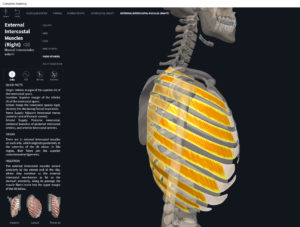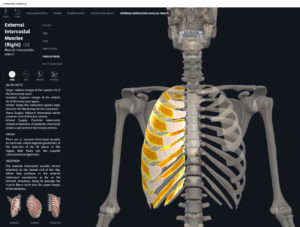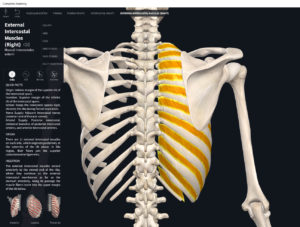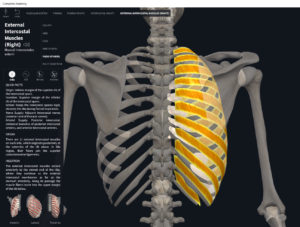Anatomy & Physiology: Muscles—External Intercostals.
Structure.
- Origin: inferior border of rib above.
- Insertion: superior border of rib below.
Function.
- Concentric action: elevate ribs and increase anteroposterior and lateral dimensions of the thoracic cavity (inhalation); contralateral rotation of trunk. Lesser: trunk flexion, extension, lateral flexion.
- Reverse mover action: depress ribs 1-11; trunk rotation, lateral flexion, flexion, ipsilateral rotation.
- Eccentric action: controls/restrains/slows depression of ribs 2-12; trunk ipsilateral rotation, flexion, extension, and contralateral lateral flexion.
- Isometric action: stabilization of ribs and trunk.
- Innervation: thoracic nerve T2-T12.
- Arterial supply: anterior intercostal arteries, posterior intercostal arteries, costocervical trunk and superior thoracic arteries.
Clinical Significance.
More.
References
Biel, A. (2015). Trail guide to the body: A hands-on guide to locating muscles, bones and more.
Cedars-Sinai. (2018). Vertebrae of the spine. Retrieved from https://www.cedars-sinai.org/health-library/diseases-and-conditions/v/vertebrae-of-the-spine.html
Clark, M., Lucett, S., Sutton, B. G., & National Academy of Sports Medicine. (2014). NASM essentials of corrective exercise training. Burlington, MA: Jones & Bartlett Learning.
Jenkins, G., & Tortora, G. J. (2012). Anatomy and Physiology: From Science to Life, 3rd Edition International Stu. John Wiley & Sons.
Muscolino, J. E. (2017). The muscular system manual: The skeletal muscles of the human body.




